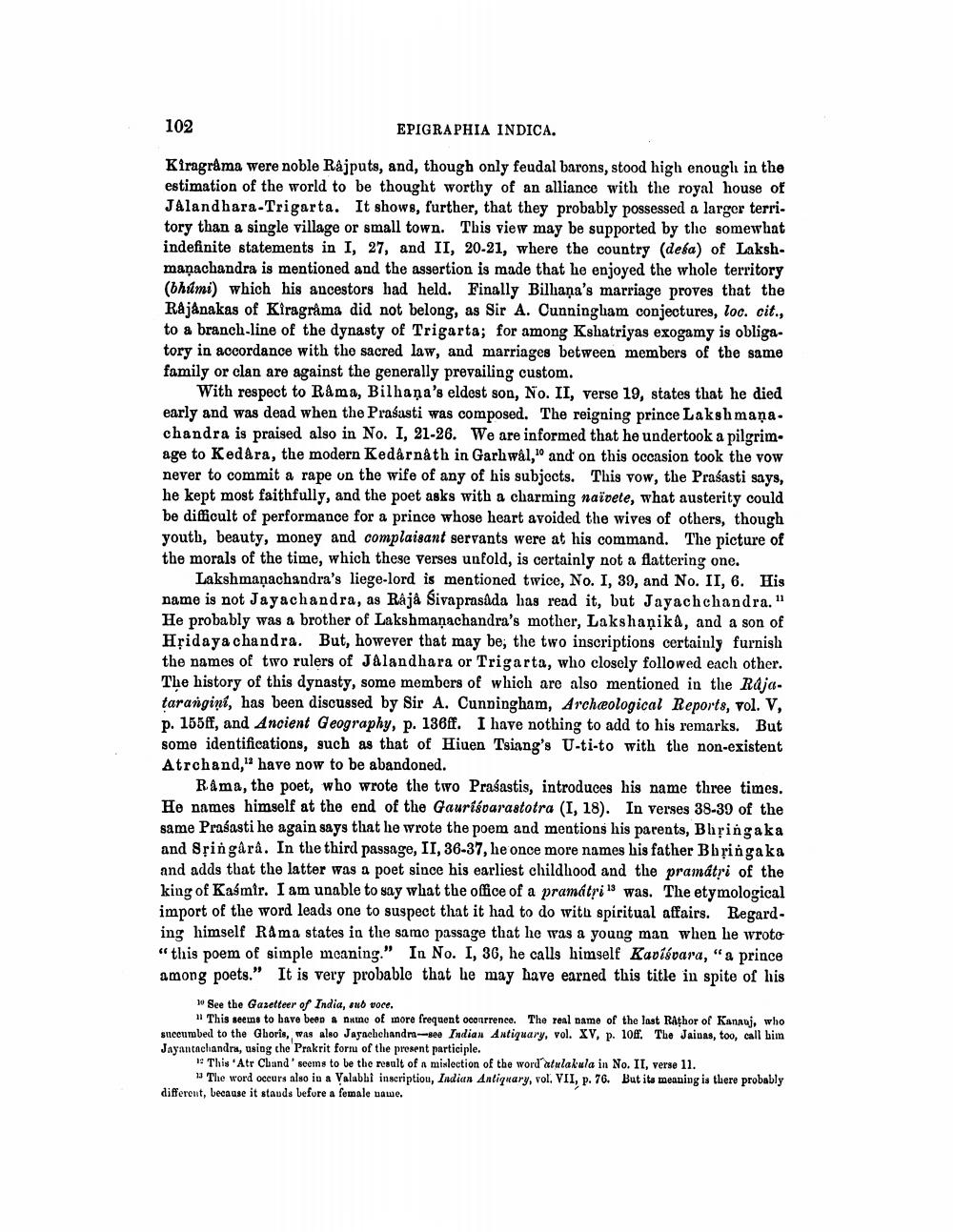________________
102
EPIGRAPHIA INDICA.
Kiragrama were noble Rajputs, and, though only feudal barons, stood high enough in the estimation of the world to be thought worthy of an alliance with the royal house of Jalandhara-Trigarta. It shows, further, that they probably possessed a larger territory than a single village or small town. This view may be supported by the somewhat indefinite statements in I, 27, and II, 20-21, where the country (defa) of Lakshmanachandra is mentioned and the assertion is made that he enjoyed the whole territory (bhúmi) which his ancestors had held. Finally Bilhaņa's marriage proves that the Rájánakas of Kiragrâma did not belong, as Sir A. Cunningham conjectures, loc. cit., to a branch-line of the dynasty of Trigarta; for among Kshatriyas exogamy is obligatory in accordance with the sacred law, and marriages between members of the same family or clan are against the generally prevailing custom.
With respect to Rama, Bilhana's eldest son, No. II, verse 19, states that he died early and was dead when the Prasasti was composed. The reigning prince Lakshmaņa. chandra is praised also in No. I, 21-26. We are informed that he undertook a pilgrimage to KedAra, the modern Kedarnath in Garhwal," and on this occasion took the vow never to commit a rape on the wife of any of his subjects. This vow, the Prasasti says, he kept most faithfully, and the poet asks with a charming naivete, what austerity could be difficult of performance for a prince whose heart avoided the wives of others, though youth, beauty, money and complaisant servants were at his command. The picture of the morals of the time, which these verses unfold, is certainly not a flattering one.
Lakshmanachandra's liege-lord is mentioned twice, No. I, 39, and No. II, 6. His name is not Jayachandra, as Raja Sivaprasada has read it, but Jayachchandra. 11 He probably was a brother of Lakshmanachandra's mother, Lakshanika, and a son of Hridaya chandra. But, however that may be, the two inscriptions certainly furnish the names of two rulers of Jalandhara or Trigarta, who closely followed each other. The history of this dynasty, some members of which are also mentioned in the Rajatarangini, has been discussed by Sir A. Cunningham, Archeological Reports, vol. V, p. 155ff, and Ancient Geography, p. 136ff. I have nothing to add to his remarks. But some identifications, guch as that of Hiuen Tsiang's U-ti-to with the non-existent Atrchand," have now to be abandoned.
Rama, the poet, who wrote the two Praśastis, introduces his name three times. He names himself at the end of the Gauri varastotra (I, 18). In verses 38-39 of the same Prasasti he again says that he wrote the poem and mentions his parents, Bhringaka and Sringarâ. In the third passage, II, 36-37, he once more names his father Bhringaka and adds that the latter was a poet since his earliest childhood and the pramátyi of the king of Kasmir. I am unable to say what the office of a pramátri 13 was. The etymological import of the word leads one to suspect that it had to do with spiritual affairs. Regard. ing himself Rama states in the same passage that he was a young man when he wroto “this poem of simple meaning." In No. I, 36, he calls himself Kavisvara, "a prince among poets." It is very probable that he may have earned this title in spite of his
See the Gazetteer of India, suo voce.
1 This seeins to have been a nutne of more frequent ocorrrence. The real name of the last Rathor of Kanadi, who succumbed to the Gboris, was also Jayaebchandra-see Indian Antiquary, vol. XV, p. 104. The Jainas, too, call him Jayantchandru, using the Prakrit form of the present participle.
1. This Atr Chand' seems to be the result of a mislection of the word'atulakula in No. II, verse 11.
The word occurs also in a Valabbt inscriptiou, Indian Antiquary, vol. VII, p. 70. But its meaning is there probably different, because it stauds before a female nawe.




